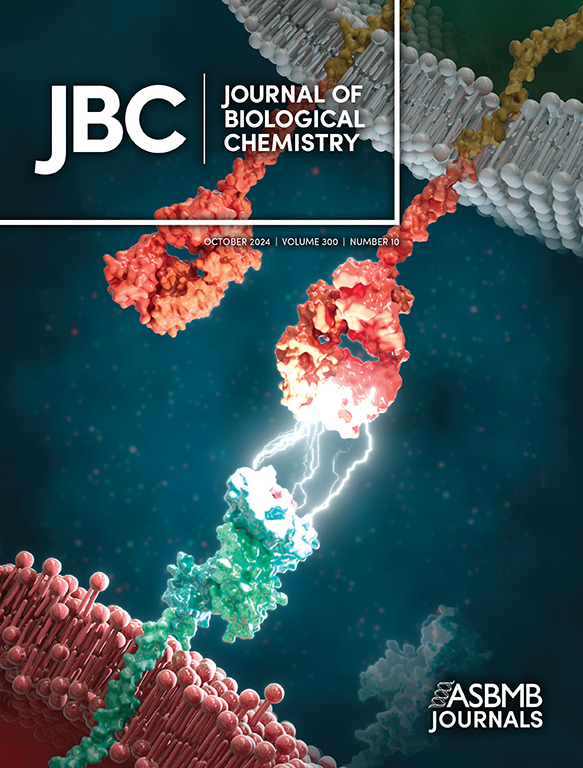Hsp110 Nucleotide Exchange Factors may amplify Hsp70-disaggregation by enhanced entropic pulling.
IF 4
2区 生物学
Q2 BIOCHEMISTRY & MOLECULAR BIOLOGY
引用次数: 0
Abstract
Hsp70s use energy from ATP hydrolysis to unfold protein structures and solubilize stable aggregates and accumulate native species, even under adverse non-native conditions. To carry out its catalytic polypeptide-unfolding activity, Hsp70 needs to reversibly interact with a J-domain (JDP) catalyst, a misfolded or alternatively-folded polypeptide substrate and a Nucleotide Exchange Factor (NEF), which binds to the Nucleotide Binding Domain (NBD), accelerates ADP-release and controls the dissociation of the unfolded polypeptide product of the unfolding reaction. In bacteria, GrpE is the ubiquitous NEF, and yet, during the process of eukaryotisation, it was lost from the cytosol, to be replaced by novel NEF proteins, among which the Hsp110 family stands out. Curiously, Hsp110s belong to the Hsp70 superfamily, but the evolutionary steps that led from an ancestral Hsp70 unfoldase to a Hsp110 NEF catalyzing other Hsp70's activity, remain unsolved. Combining experiments using wild-type Sse1 (yeast Hsp110) and rationally designed mutants, we show that Hsp110 is likely built upon some distinctive features already present in Hsp70 by repurposing them, rather than by fashioning novel molecular properties. Taking all results together, we suggest a novel mechanism of action of Hsp110, whereby it is a NEF that also enhances the unfolding/disaggregating entropic pulling forces generated by Hsp70, by transiently increasing the chaperone effective volume.Hsp110核苷酸交换因子可能通过增强熵拉来放大hsp70的分解。
hsp70利用ATP水解产生的能量来展开蛋白质结构,溶解稳定的聚集体并积累本地物种,即使在不利的非本地条件下也是如此。为了实现其催化多肽展开活性,Hsp70需要与j结构域(JDP)催化剂、错误折叠或交替折叠的多肽底物和核苷酸交换因子(NEF)可逆相互作用,NEF与核苷酸结合结构域(NBD)结合,加速adp的释放并控制展开反应中未折叠多肽产物的解离。在细菌中,GrpE是普遍存在的NEF,然而,在真核化过程中,它从细胞质中丢失,被新的NEF蛋白所取代,其中Hsp110家族尤为突出。奇怪的是,Hsp110属于Hsp70超家族,但从祖先的Hsp70展开酶到催化其他Hsp70活性的Hsp110 NEF的进化步骤仍未解决。结合使用野生型Sse1(酵母Hsp110)和合理设计的突变体进行的实验,我们发现Hsp110可能是通过重新利用Hsp70中已经存在的一些独特特征,而不是通过形成新的分子特性来构建的。综合所有结果,我们提出了Hsp110的一种新的作用机制,即它是一种NEF,通过瞬时增加伴侣分子的有效体积,增强Hsp70产生的展开/分解熵拉力。
本文章由计算机程序翻译,如有差异,请以英文原文为准。
求助全文
约1分钟内获得全文
求助全文
来源期刊

Journal of Biological Chemistry
Biochemistry, Genetics and Molecular Biology-Biochemistry
自引率
4.20%
发文量
1233
期刊介绍:
The Journal of Biological Chemistry welcomes high-quality science that seeks to elucidate the molecular and cellular basis of biological processes. Papers published in JBC can therefore fall under the umbrellas of not only biological chemistry, chemical biology, or biochemistry, but also allied disciplines such as biophysics, systems biology, RNA biology, immunology, microbiology, neurobiology, epigenetics, computational biology, ’omics, and many more. The outcome of our focus on papers that contribute novel and important mechanistic insights, rather than on a particular topic area, is that JBC is truly a melting pot for scientists across disciplines. In addition, JBC welcomes papers that describe methods that will help scientists push their biochemical inquiries forward and resources that will be of use to the research community.
 求助内容:
求助内容: 应助结果提醒方式:
应助结果提醒方式:


